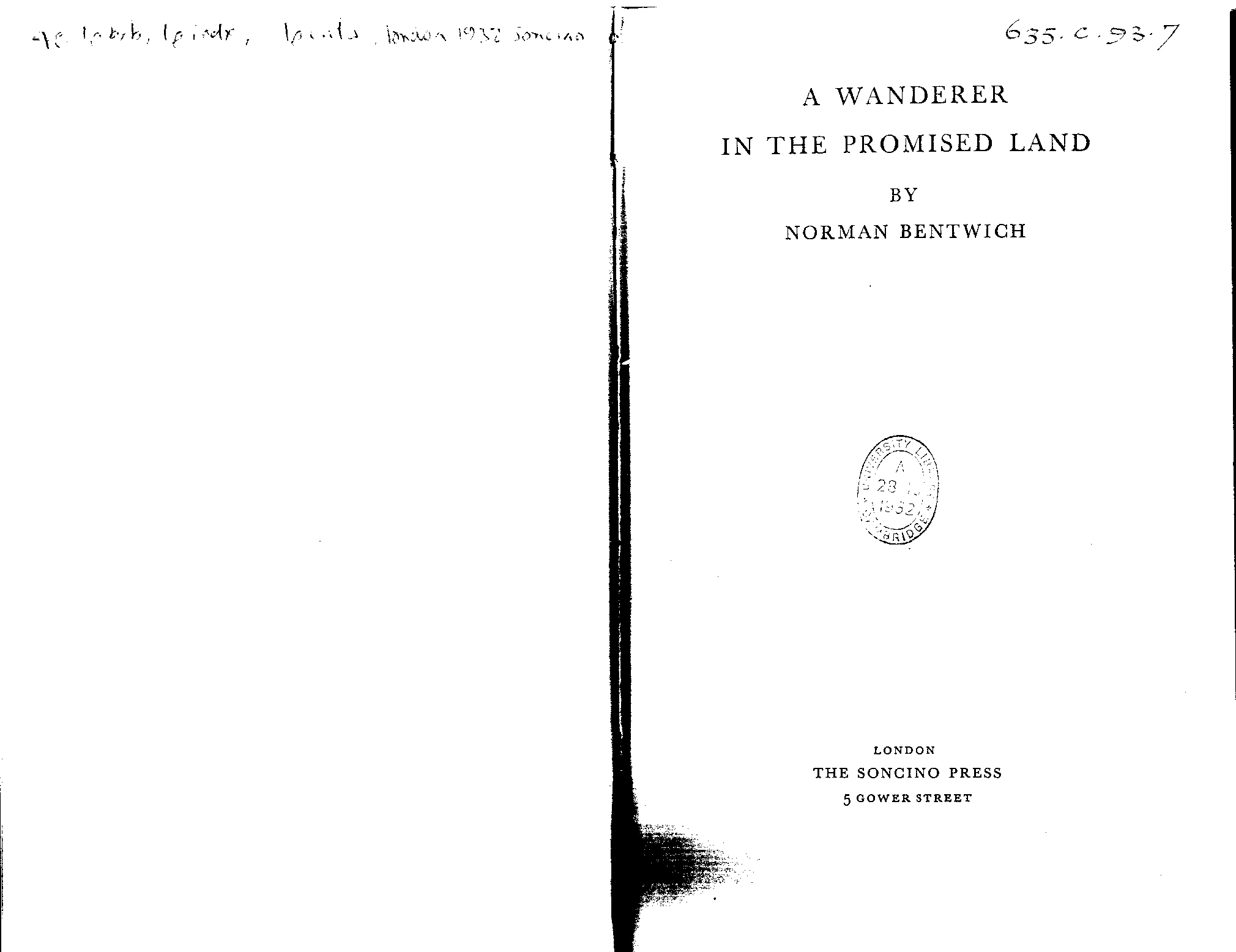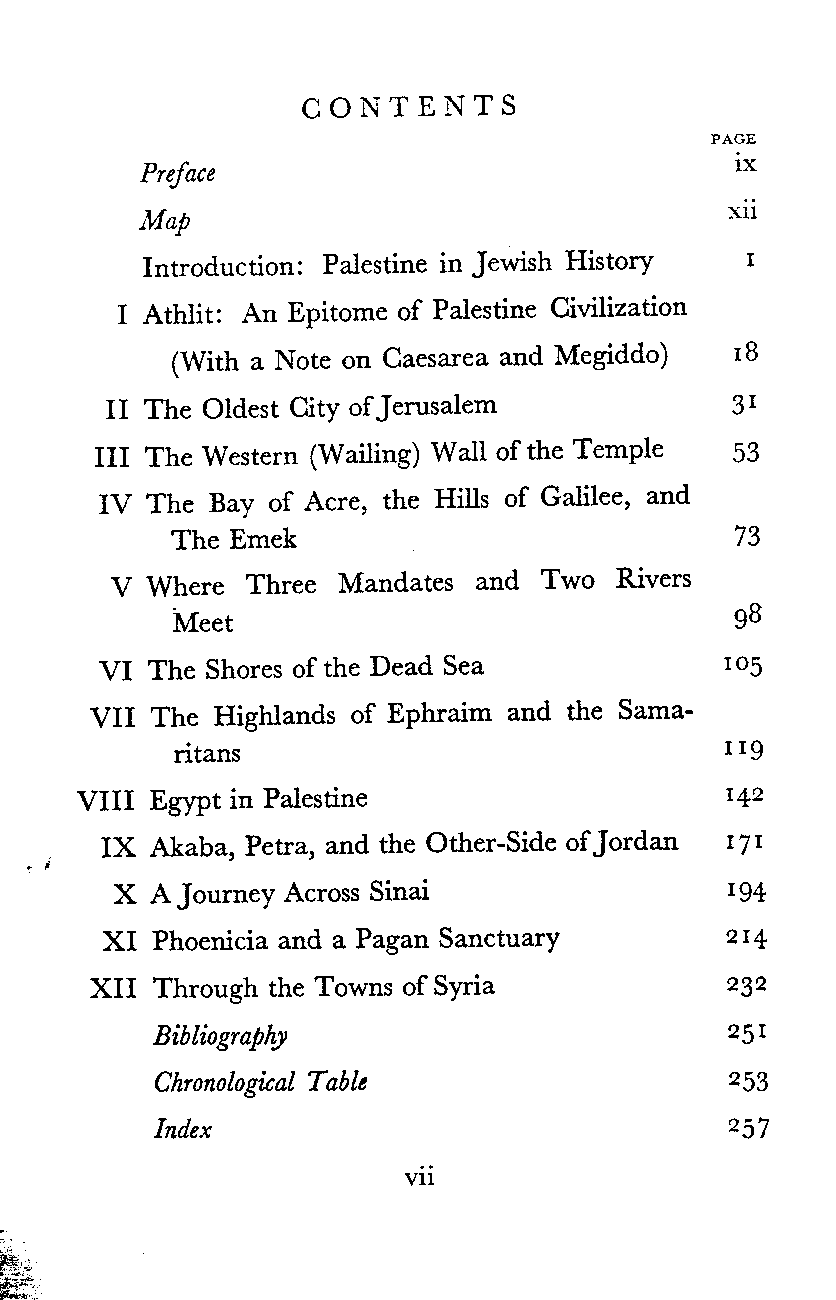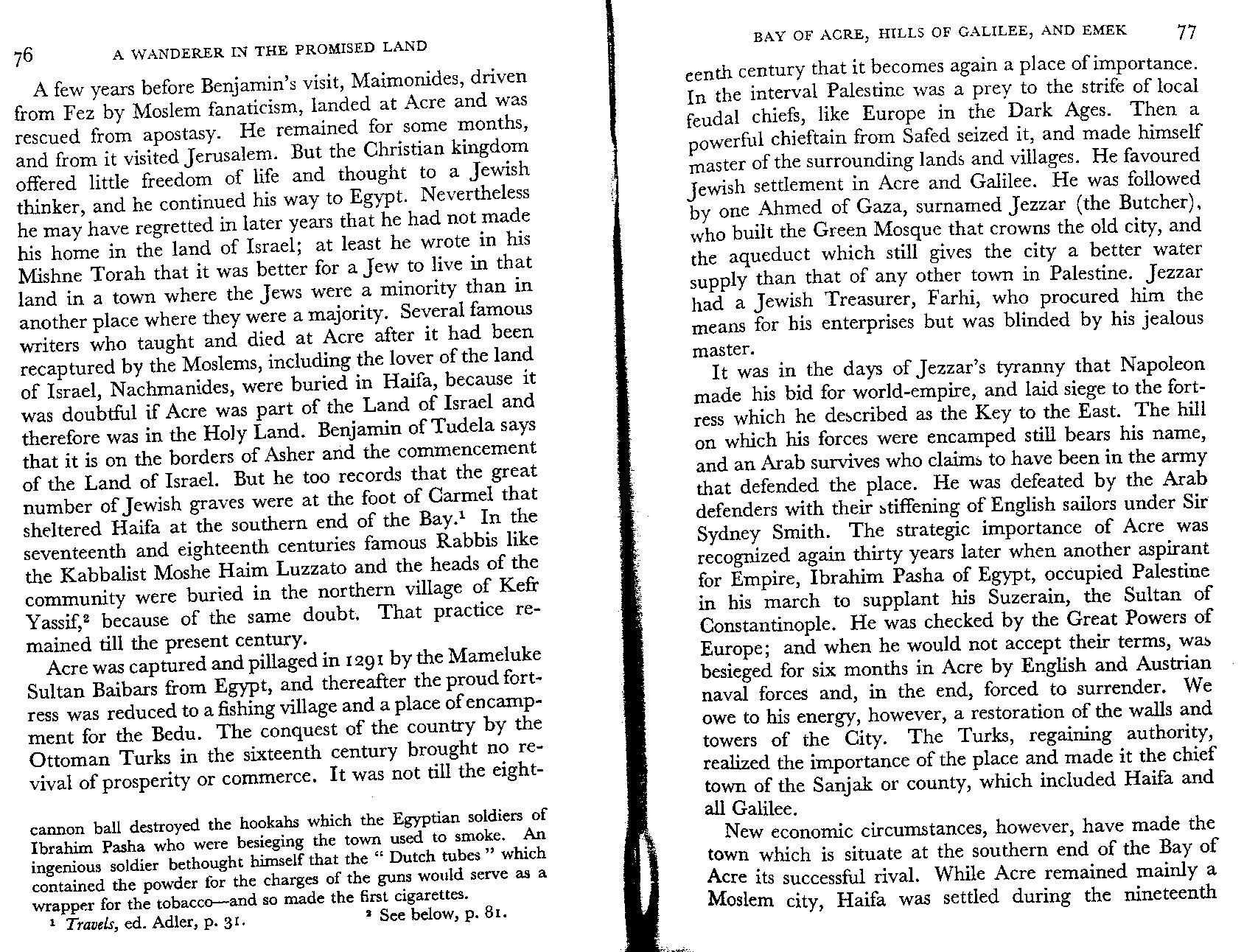
|
|
Abstract: Four pages on the history of Akka, including two on the Bahá'ís. |
1. Text
A few years before Benjamin's visit, Maimonides, driven from Fez by Moslem fanaticism, landed at Acre and was rescued from apostasy. He remained for some months, and from it visited Jerusalem. But the Christian kingdom offered little freedom of life and thought to a Jewish thinker, and he continued his way to Egypt. Nevertheless he may have regretted in later years that he had not made his home in the land of Israel; at least he wrote in his Mishne Torah that it was better for a Jew to live in that land in a town where the Jews were a minority than in another place where they were a majority. Several famous writers who taught and died at Acre after it had been recaptured by the Moslems, including the lover of the land of Israel, Nachmanides, were buried in Haifa, because it was doubtful if Acre was part of the Land of Israel and therefore was in the Holy Land. Benjamin of Tudela says that it is on the borders of Asher and the commencement of the Land of Israel. But he too records that the great number of Jewish graves were at the foot of Carmel that sheltered Haifa at the southern end of the Bay. [footnote 1: Travels, ed. Adler, p. 31.] In the seventeenth and eighteenth centuries famous Rabbis like the Kabbalist Moshe Haim Luzzato and the heads of the community were buried in the northern village of Kefr Yassif, [footnote 2: See below, p. 81.] because of the same doubt. That practice remained till the present century.Acre was captured and pillaged in 1291 by the Mameluke Sultan Baibars from Egypt, and thereafter the proud fortress was reduced to a fishing village and a place of encampment for the Bedu. The conquest of the country by the Ottoman Turks in the sixteenth century brought no revival of prosperity or commerce. It was not till the eighteenth century that it becomes again a place of importance. In the interval Palestine was a prey to the strife of local feudal chiefs, like Europe in the Dark Ages. Then a powerful chieftain from Safed seized it, and made himself master of the surrounding lands and villages. He favoured Jewish settlement in Acre and Galilee. He was followed by one Ahmed of Gaza, surnamed Jezzar (the Butcher), who built the Green Mosque that crowns the old city, and the aqueduct which still gives the city a better water supply than that of any other town in Palestine. Jezzar had a Jewish Treasurer, Farhi, who procured him the means for his enterprises but was blinded by his jealous master.
It was in the days of Jezzar's tyranny that Napoleon made his bid for world-empire, and laid siege to the fortress which he described as the Key to the East. The hill on which his forces were encamped still bears his name, and an Arab survives who claims to have been in the army that defended the place. He was defeated by the Arab defenders with their stiffening of English sailors under Sir Sydney Smith. The strategic importance of Acre was recognized again thirty years later when another aspirant for Empire, Ibrahim Pasha of Egypt, occupied Palestine in his march to supplant his Suzerain, the Sultan of Constantinople. He was checked by the Great Powers of Europe; and when he would not accept their terms, was besieged for six months in Acre by English and Austrian naval forces and, in the end, forced to surrender. We owe to his energy, however, a restoration of the walls and towers of the City. The Turks, regaining authority, realized the importance of the place and made it the chief town of the Sanjak or county, which included Haifa and all Galilee.
New economic circumstances, however, have made the town which is situate at the southern end of the Bay of Acre its successful rival. While Acre remained mainly a Moslem city, Haifa was settled during the nineteenth century by Christians who venerated Mount Carmel in whose shade it was built, by Jews who divined its coming importance, and by German "Templars" who, coming to the Holy Land in the latter part of the century to establish a more Christian way of life, placed their chief settlement on the promontory of Carmel and made the town the most civilized in the land. And while Acre was a natural harbour of the ancient and medieval eras, Haifa offered better conditions for a modern harbour for big ships, and has been chosen for the chief British port of the Eastern Mediterranean. Haifa, too, at the beginning of this century, became the outlet of the Hedjaz Railway; and the joining of that line with the Railway which the British built from Egypt through the Sinai desert to Palestine during the War has destined it a& the entrepôt for the trade of the growing hinterland.
Nevertheless, Acre to-day is growing and expanding as an appendage and satellite of Haifa, and Jewish settlement has begun to penetrate its walls. Its fortress still stands superb, and its ramparts form the most picturesque city girdle in Palestine. During the riots of 1929 the Jewish populace was placed for safety within the fortress, which is the principal prison of the Government; and it was reported by the Arab District Officer that "the Jews were in safety in the British Museum." Beneath the prison is a Crusader church, which is now being excavated; and the garden of the fortress has been made lovely as the garden of an English cathedral close.
Another beautiful garden which makes Acre a place of pilgrimage, but is in the Persian and not in the English character, is known as El Bahshi. It is the burial-place of the Persian Reformer Baha-Ullah, whose name means the glory of God. He was the leader of the Universalist movement which was derived from the Shia branch of Islam in Persia one hundred years ago, and is known today as Bahaism — after the first part of his name. His coming was foretold by an ardent Shia Moslem, Mirza Ali Mohammad who assumed the title of the Bab, that is, the Gate: because he claimed to be the gate to the new era, "the channel of grace for some great being still behind the veil of glory." Mirza was martyred in Persia; but his body was brought later by his followers to Palestine and is buried on the slopes of Carmel above Haifa in a Persian garden. Above and under his resting-place his followers are making a series of nineteen terraces, corresponding with the number of his disciples, that are designed to lead from the top of the Carmel to the town. No monument or tablet mars the simple beauty of the flowered and terraced garden.
Baha-Ullah was one of the nineteen disciples of the Bab, and was persecuted with his master. He was rigorously 1mprisoned for some years in his native Persia, and subsequently exiled to Bagdad (then under Turkish rule) where he claimed to be the Prophet and preached the universal teaching. The Sultan of Turkey took alarm at the spreading of the new religion, and caused Baha to be brought to Constantinople, and later exiled him to Acre and imprisoned him in its fortress for many years. Eventually he was released, and he made his home in Acre and Haifa. He wrote to the Kings and other rulers of Europe announcing his mission, and calling on them to bend their energies to the establishment of the true religion, just government and international peace; and after his death he was revered as a prophet by a vast number of followers in Persia and the Orient. His son Abbas Abdul-Baha (that is, the servant of the glory), was born in Persia and imprisoned at Acre with his father when a young man; but most of his life he lived a free man at Haifa and was revered as a sage by the people around. He carried the preaching of the new faith to Europe and America, but his home was in Haifa. He was there during the war, and remained after the British Occupation, respected by the British authorities. He died in 1924, and is buried with the Bab in the garden on the Carmel. In 1914 he had a vision of Haifa as the coming commercial capital of the Orient:
"In the future the distance between Acre and Haifa will be built up and the two cities will clasp hands, becoming the two ends of one mighty metropolis. The great semicircular bay will be transformed into a fine harbour wherein the ships of all nations will seek shelter and refuge. . . . The flowers of civilization and culture from all nations will be brought here to blend their fragrances together. . . . A person standing on the summit of Mt. Carmel and the passengers on the steamers coming to it will look upon the most sublime and majestic spectacle of the world."That vision is being remarkably fulfilled in our day.
When Abbas died in 1924, the headship — or guardianship — passed to his grandson who, educated at Oxford, continued to live at Haifa. His house and the hostel of the Bahais which have sprung up beside it are an oasis of religious peace. Palestine may indeed be now regarded as the land of four faiths, because the creed of the Bahais, which has its centre of faith and pilgrimage in Acre and Haifa has attained the character of a world-religion. The main ideas of its universalism are the oneness of mankind and the harmony of religions. Baha-Ullah its principal teacher proclaimed: "Let not a man glory in this that he loves his country, but let him glory in this that he loves his kind"; and Abbas used to declare that the supreme gift of God to this age is knowledge of the oneness of mankind and of the fundamental unity of religions.
2. Image scans (click image for full-size version)

|
|





